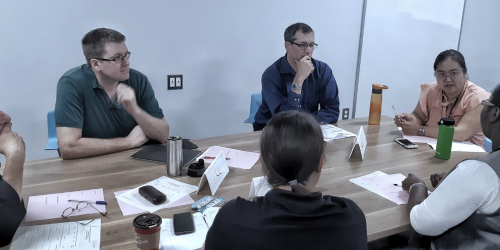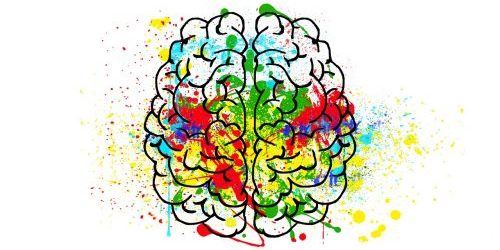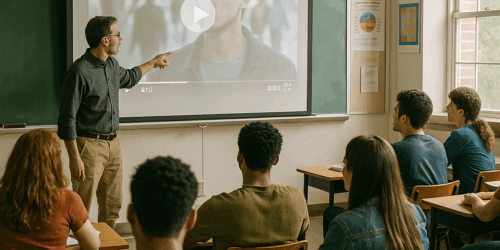
“Involve Me and I Learn”- The Connection Between Active Learning and How the Brain Learns
Tell me and I forget. Teach me and I remember. Involve me and I learn.
Benjamin Franklin
Conestoga College endorses active learning to promote an engaging and positive learning experience for the students. Active learning is an approach to teaching and learning where teachers involve the students in the learning process by using various strategies. However, why do students learn more with active learning? In this teaching tip, we explore the rationale behind active learning classrooms and explain how the brain learns more with active learning strategies.
Does Active Learning Mean Only Create Activities?
Active learning does not mean only creating activities in the classroom. Instead, active learning promotes the implementation of various teaching and learning methods and activities to put “the learners in a position to think about and apply what they are learning in a real-world meaningful context” (Poole. 2021, p. 69). When teachers create an activity, they aim to activate students’ prior learning, understanding, and perspectives about the topic. Active learning is not about playing games with the students; instead, active learning helps the students make connections between the games or interactive activities and their learning. Freeman and his colleagues (2014) meta analyzed 225 studies and found that average examination scores were improved by about 6% in active learning sections compared to the students in classes with traditional lecturing. The examination scores are likely to improve because students have learned. Brame (2016) makes a crucial connection between activities and students’ learning:
…activities that students do to construct knowledge and understanding. The activities vary but require students to do higher order thinking. Although not always explicitly noted, metacognition—students’ thinking about their own learning—is an important element, providing the link between activity and learning.”
So, active learning aims to engage students and activate higher order of learning and metacognition. How do we do these? To answer this question, we need to know how the brain learns. The following section discusses the relationship between active learning and neuroscience.
Neuroscience and Active Learning
Studies in neuroscience reveal that employing a multimodal learning style leads to better retention and brings long-term changes in the brain. Students working with each other require more cognitive and sensory network involvement than passively learning from a teacher (Hoogendoorn, 2015). For example, when students are involved in a group discussion, they talk, listen to each other, give replies or reactions, and experience a wide range of emotions, making the student more involved in the lesson.
How Does the Brain Behave in an Active Learning Classroom?
When the brain learns a new piece of information, the neurons start firing while coding for various aspects of the new information. This coding and firing process aims to create connections between various information we already have in our brain. In Hoogendoorn’s (2015) words, when neurons from different areas respond to the same stimuli, they become ‘friends.’ This how two areas of the brain meet and make connections. In the absence of active learning, neurons make weak connections. See the example below:

So, when I allow the students to discuss Canada day, different parts of their brains are activated, and the students experience the lesson instead of passively listening to the teacher about Canada Day. Hoogendoorn (2015) comments that the more areas in the brain make connections, the more chances there are to retain the memory for a longer time.
Finally, as teachers, we need to learn more about how the brain learns to design our activities closely. A takeaway activity for this reading would be to reflect on one of your class activities and draw a visual graph of how probably your students are making various connections in their brains.
Self-reflective questions for designing active learning activities:
- How is the activity connected to my learning outcomes?
- What am I aiming at by doing the activity?
- What is the rationale behind the activity?
- How does the activity help the students to make connections?
- Does the activity endorse higher order of learning?
- Does the activity activate more areas of the brain?
References:
Brame, C. (2016). Active Learning. Vanderbilt University Center for Teaching. https://cft.vanderbilt.edu/guides-sub-pages/active-learning.
Freeman, S., et al. (2014). Active learning increases student performance in science, engineering, and mathematics. Proceedings of the National Academy of Sciences, 111(23): 8410-8415
Hoogendoorn, C. (2015, October 15). The Neuroscience of Active Learning. Open Lab. https://openlab.citytech.cuny.edu/writingacrossthecurriculum/2015/10/15/the-neuroscience-of-active-learning/
Poole, K. 2021. A flipped classroom approach to teaching search techniques for systematic reviews to encourage active learning. Journal of Information Literacy, 15(1), pp. 68–83







I have learned that stimulating the brain with new material through various techniques creates an environment of higher learning.
Personally, I can relate to it as working out at a Gym vs playing a sport. Another way to look at it is learning MS Excel as a theoretical subject vs exploring MS Excel while actually crunching numbers for a critical business decision.
My learning is that when several teaching techniques are used to introduce new subjects or topics this will create a stimulating and enriched learning
Highly rich content.
This definitely gives a deep perspective to teaching and learning, beyond the traditional concept or approach to learning
I agree that by using different techniques of Active Learning help student to learn more
Theory and practice – I believe you need both in order to learn successfully. Understand why something is the way it is, and then use it to understand its relevancy.
Just like exercising the cardiovascular system or the body’s muscles, I think that it’s very important to exercise or stimulate the mind by introducing different modalities.
Nicely written! I plan on using this blog in my learning and development course:)